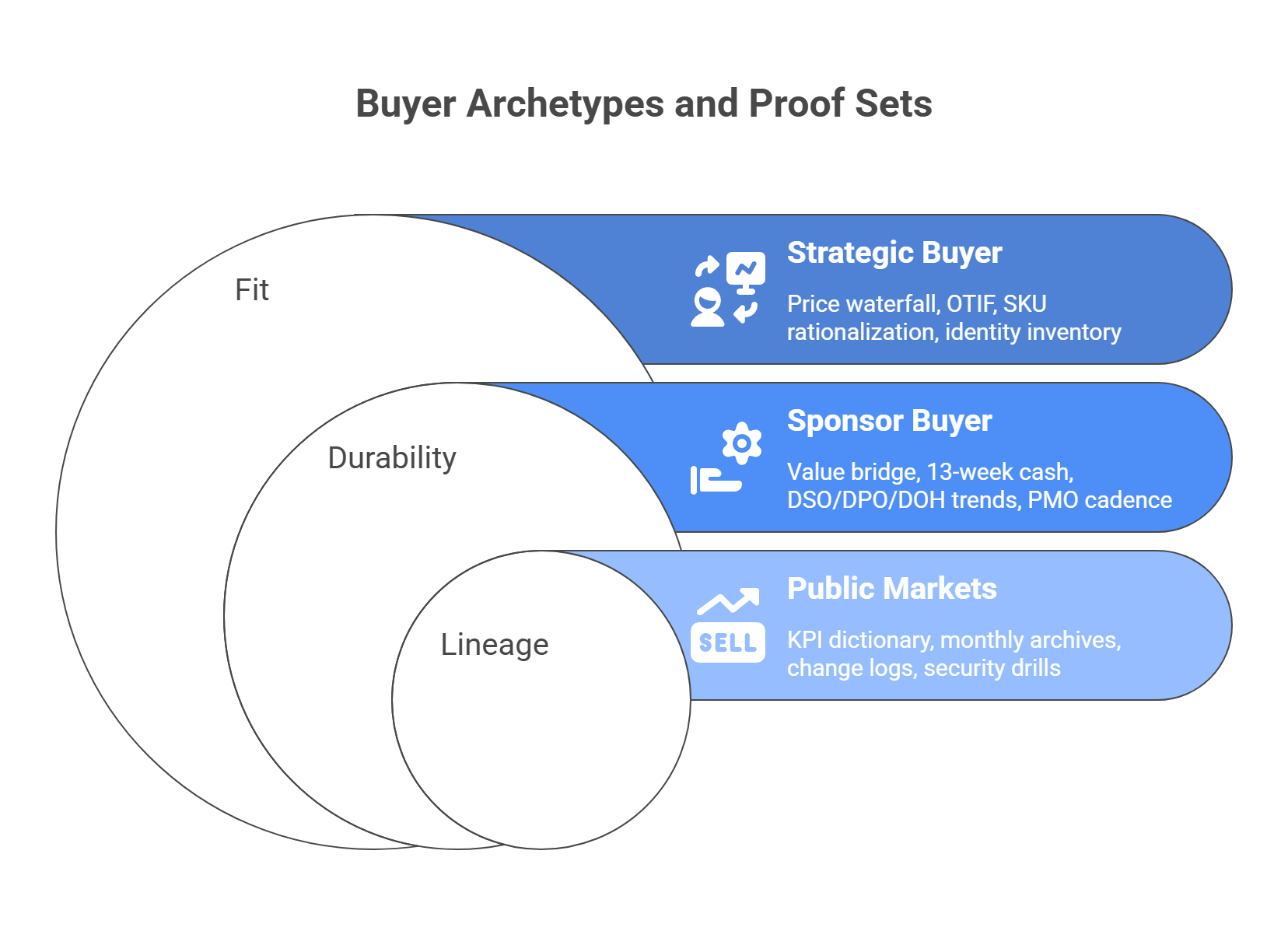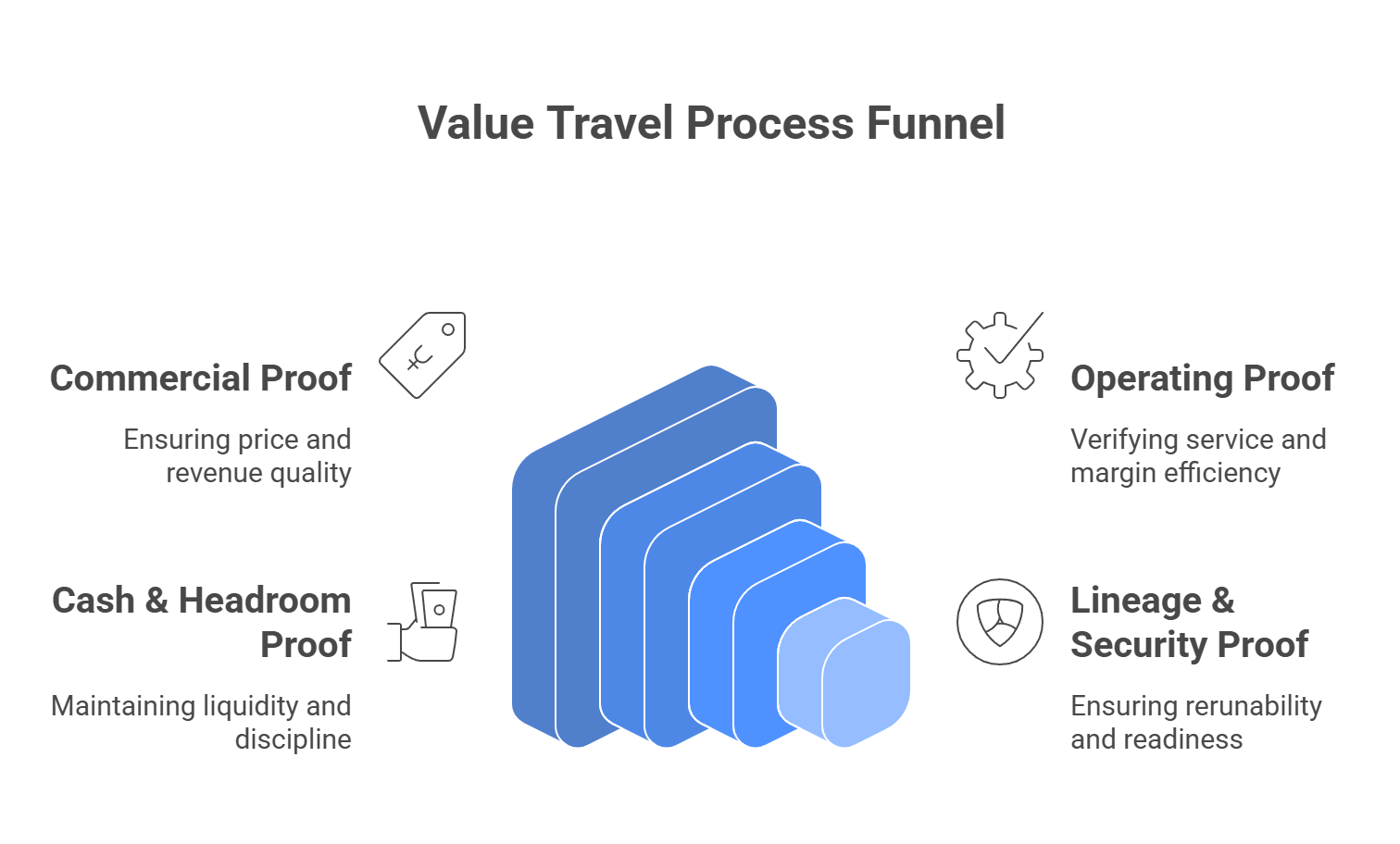The Exit-Back Playbook: Write the Exit at Signing, Then Run to the Evidence
Oct 25, 2025
In today’s market, exits don’t reward the loudest story; they reward the cleanest proof. That’s why high-performing PE teams work backwards: define the most likely buyer, codify what that buyer will need to see, and operate month-to-month so the evidence assembles itself. The result is less drama at close, fewer value chips left on the table, and options when windows tighten.
1) Why “exit-back” now
-
Selective windows: IPOs open for operationally tidy assets; strategics pay for de-risked adjacencies; sponsors need verifiable cash to underwrite leverage.
-
Higher scrutiny: Lenders and ICs discount narratives that can’t be rerun.
-
Longer holds: Your archive becomes the asset—if you build it on purpose.
Exit-back converts the exit from a late-stage marketing campaign into an operating system you run from Day 1.

2) Start with the buyer map (three archetypes, three proof sets)
-
Strategic buyer: cares about fit—price power that will hold, service promises that won’t break their network, clean data and access so integration is fast.
Proof set: price waterfall + CPQ rules, OTIF & exception codes, SKU rationalization logic, identity/connector inventory. -
Sponsor buyer: cares about durability—repeatable levers, headroom, predictable working capital.
Proof set: value bridge with before/after levers, 13-week cash with bank tie-outs, DSO/DPO/DOH trends with policy outcomes, PMO cadence. -
Public markets (selective): care about lineage—definitions frozen, KPI math that matches the ledger every time.
Proof set: KPI dictionary with stored scripts, immutable monthly archives, change logs, security drills.
Pick your most likely buyer on Day 1; you can pivot later. The packets largely overlap when you build them right.

3) The four packets that make value travel
-
Commercial Proof (Price & Revenue Quality)
-
Price waterfall: list → pocket, five quarters of history.
-
CPQ rules: floors, bands, approvals; override log with reason + expiry.
-
Cohort health: GRR/NRR with retention shape by segment and offer.
-
-
Operating Proof (Service & Margin)
-
OTIF and exception codes (carrier, slotting, order cut-offs).
-
Cost-to-Serve driver map; contribution by SKU/service family.
-
Catalog simplification: retired variants, policy changes, and impact.
-
-
Cash & Headroom Proof (Liquidity & Discipline)
-
13-week cash tile, reconciled weekly to bank.
-
Working-capital bridge with dispute closures, AP calendar, inventory actions.
-
Covenant headroom trend with triggers and pre-agreed levers.
-
-
Lineage & Security Proof (Rerunability & Readiness)
-
KPI dictionary and stored scripts with “as-of” stamps.
-
Access inventory (joiner-mover-leaver), MFA coverage, third-party connectors.
-
Incident drills: who did what, how fast, what changed.
-
Each packet should be rerunnable in 30 minutes by a buyer without your team in the room.
4) Operating cadence that assembles the packets (without extra work)
-
Weekly Performance Room (45 min): value bridge → five deltas → decisions; decision register updated.
-
Pricing Council (30 min): realization trend; override log; rule changes approved.
-
Cash Stand-Up (30 min): forecast vs actual; AR/AP/inventory actions; headroom bar.
-
Monthly Archive (30 min): export scripts, reconciliations, and packets to immutable storage; publish a short methods note.
No new meetings—just a tighter spine. Packets are by-products of good management.

5) Price narrative that buyers don’t argue with
-
Rules in tools: CPQ is the single source of truth; discounts outside bands expire.
-
Talk tracks shipped: sales can hold the line or trade for value without heroics.
-
Realization proof: segment view; exceptions decay over time.
-
What a buyer sees: consistent uplift, disciplined exceptions, and muscle that will hold post-close.
6) Margin narrative that survives turnover
-
Cost-to-Serve, not vibes: allocate by a few defensible drivers (picks, stops, handle time).
-
Contribution by family: track, act, and show effect of policy changes (MOQ, rush fees, returns).
-
SKU diet: retire long-tail variants that create handling chaos; show the cash/margin effect.
-
What a buyer sees: fewer apologies, simpler ops, steadier margin per unit.
7) Liquidity narrative that lowers spreads
-
One-tile, 13-week: reconcile to bank weekly; variance reason codes; 24-hour closure.
-
Working-capital rules: dispute SLAs, AP calendar wired to covenants, two-family inventory focus.
-
Borrowing-base hygiene: ineligibles by reason; advance-rate sensitivity.
-
What a buyer/lender sees: predictability, earlier sightlines on stress, and levers already in motion.
8) Security narrative that prevents “last-mile” deal risk
-
Identity hygiene: role-based access, MFA for named roles, connector map.
-
Drills with timestamps: incident runbooks rehearsed, fixes logged.
-
Data lineage: scripts under version control; KPI definitions frozen and versioned.
-
What a buyer sees: lower integration risk, fewer surprises, faster Day-1.
9) Integration-ready by design (so the synergy math clears)
-
Fit proof first: route-to-market, price fences, service promises aligned before synergy claims.
-
Day-1/30/100 relay: revenue protected → bands & terms harmonized → tools/SKUs rationalized.
-
Probability-weighted synergy register: owner, ramp, cash conversion, TSA burn-down.
-
What a buyer sees: math grounded in operating reality, not aspiration.
10) Antipatterns that quietly destroy exit value
-
List-price heroics: pocket price flat; no CPQ enforcement.
-
Dashboard cosplay: pretty charts, no scripts; definitions drift.
-
Pilot purgatory: many AI demos; zero production; no kill switch.
-
Run-rate fiction: synergies without probability or cash path.
-
Archive amnesia: six months before a process, nothing reruns cleanly.
Kill these early; multiples rise quietly.
11) What changes on Monday morning
-
Turn on the decision spine (performance room, pricing council, cash stand-up).
-
Publish CPQ bands; start the override log with reason + expiry.
-
Launch two CTS policy changes and measure contribution lift.
-
Reconcile the 13-week cash to bank and label variances.
-
Create the KPI dictionary; store scripts; archive Month-End Pack v1.
-
Add a decision register—if it isn’t dated, it didn’t happen.
Do this for 90 days and you’ll have a buyer-grade binder without a special project.
12) Rehearse the buyer Q&A (and win the room in 12 minutes)
-
“Show discount control.” Open CPQ rules; walk the override log; show expiry trend.
-
“Prove OTIF improved cash.” Exceptions down → credits down → DOH down (two families).
-
“Rerun contribution for Q2.” Execute stored script; reconcile to ledger; show CTS policy effect.
-
“How resilient is liquidity?” 13-week tile; variance codes; pre-agreed levers by covenant trigger.
-
“Is security a risk?” Access inventory; connector map; drill log with time to contain.
Twelve minutes, five proofs, no theatrics.
VCII Note and Copyright
TVC Next installs exit-back as a working rhythm—pricing rules that hold, CTS habits that stick, cash visibility that buys time, and buyer-grade evidence that travels—so optionality is designed in from Day 1.
Copyright © 2025 VCII, Meritrium Corp. All rights reserved.
We have many great affordable courses waiting for you!
Stay connected with news and updates!
Join our mailing list to receive the latest news and updates from our team.
Don't worry, your information will not be shared.
We hate SPAM. We will never sell your information, for any reason.


